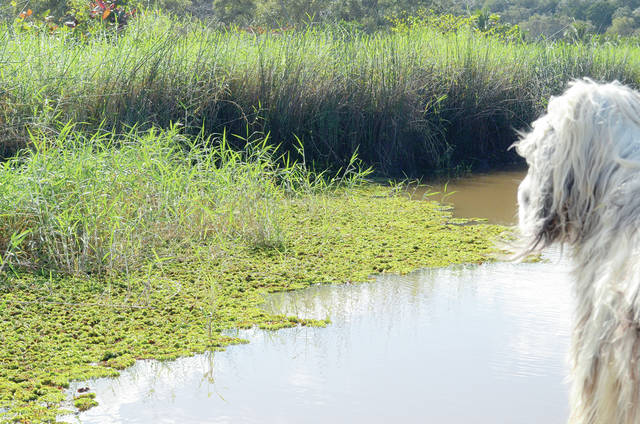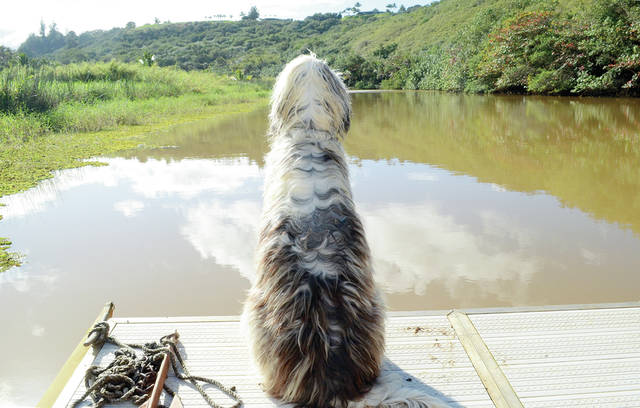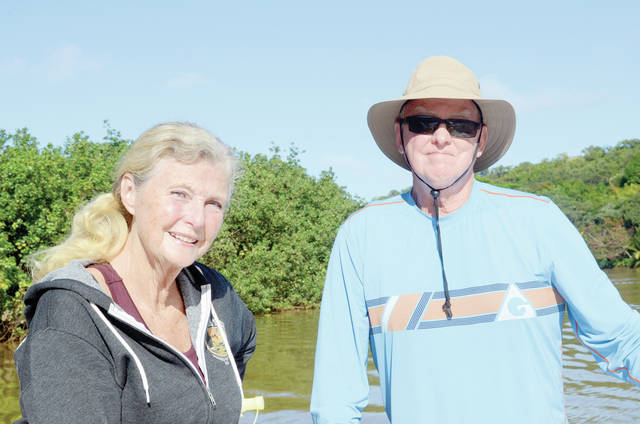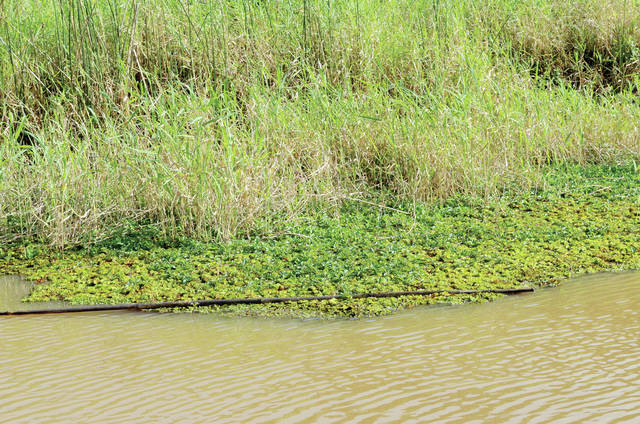Pam and Bob Warren are on a mission to save the river

Jessica Else / The Garden Island
Hewa, Pam and Bob Warren’s dog, checks out salvinia along the edges of the Kilauea River while cruising on the pontoon.

Jessica Else / The Garden Island
Hewa, Pam and Bob Warren’s dog, checks out salvinia along the edges of the Kilauea River while cruising on the pontoon.

Jessica Else / The Garden Island
Pam and Bob Warren

Jessica Else / The Garden Island
Salvinia, an invasive water fern, is clustering along the edges of the Kilauea River.
The water was especially brown in the Kilauea River in early February, as Bob and Pam Warren prepared to fly to Oahu for an invasive species awards ceremony at which they were being honored.
The water was especially brown in the Kilauea River in early February, as Bob and Pam Warren prepared to fly to Oahu for an invasive species awards ceremony at which they were being honored.
Recent rains had made the river muddy for days, Pam pointed out as she observed the water from their home, which overlooks the Kilauea River just above the river mouth at Kahili Beach, also known as Rock Quarry Beach.
The sun broke through the clouds, illuminating mats of bright green plants on the edges of the river and Pam pointed that out as well — salvinia, an invasive weed that’s been trying to take over the river, and the reason for their trip to Oahu.
For 10 years the couple has been battling the invasive fern, which overtook Oahu’s 325-acre Lake Wilson and triggered a 2003 cleanup effort with a price tag of more than $1 million.
For their efforts with invasive species in 2018, Pam and Bob received the Community Hero Award from the Hawaii Invasive Species Council on Feb. 9. The award was presented at the Hawaii Invasive Species Awareness Month awards ceremony at the Governor’s Chambers.
Two days before they received the award, Pam and Bob took TGI down the river to show us what they’ve been doing to help save Kilauea River from a salvinia take-over.
TGI: What drives your desire to preserve Kilauea River?
Pam: Obviously we have a vested interest in the river. We’re sailors and scuba divers. We like the water. That’s what endeared us to this piece of property. We bought the property in 2001 and built the house and moved in in 2005. Every weekend you’d be astounded at how many people use the river. Stand up, put out crab pots, fish in the river and little kids play in the river mouth and they kayak this constantly.
Bob: Kauai is the only island that has any rivers, and we have five of them. They’re the only five navigable rivers in the state of Hawaii and if these get trashed. … I’ve been told by (the Division of) Aquatic (Resources) that it’s in other rivers already here. It not only can get in rivers, but it’ll grow faster in some of our reservoirs. If it’s really moving it won’t work.
You look at Texas or Louisiana where this has happened for the last 20 years, and you’ll see it’ll take a waterway and completely kill and choke it. You can’t put boats or paddle boards on it anymore — it’s just a mat of this salvinia fern.
The plan is to try and keep interest up and get something going. If it takes five years from now, it’s going to get worse and you’ll have a problem that is 10 or 20 times worse than it is now. The sooner we can address it, the sooner we can get it under control.
TGI: When did salvinia start growing in the river and what’s the problem with it?
Bob: The problem with it is if it gets much over 40 or 50 percent coverage, what happens is it blocks the sunlight from the algae which creates the oxygen and everything depends on. The river would die, nothing would grow in the river.
Where this really started was 10 years ago and we noticed some clumps of salvinia in the river. We had a relationship with Kauai Invasive Species Council and so we called them and they came right out. They got approval to use this spray to control it called AquaMaster. It’s non-toxic and you don’t have to worry about wearing gloves or clothes or anything else when you’re spraying it. It’s biodegradable over time, and that’s what it’s made for.
With that (AquaMaster spray), we kept it under control. They’d come out four or five times a year and we’d use my little pontoon boat and we kept it under control for about five years. Then five years ago, I called and told them they needed to come out and they said the state said we can’t use the spray.
Without using the spray we don’t know how to control it. So they started on a search to try and figure out what else we could do. It took us five years — we went to Sierra Club, Surfrider, EPA, anyone we could think of — and finally one of our friends had someone that was an aquatic botanist and they said “There’s a whole group at DLNR (that deals with) aquatic species.”
We contacted them and they said we’re familiar with it because of Lake Wilson on Oahu. They said “That’s a real problem, we’ll be over.” It was the first time we found anyone in government that gave us the time of day and they jumped on it.
Pam: We had a cleanup with about eight people in 2016, and then last year we had a bigger agency presence. That was in October or September of 2017. There was a big gap between the community effort and we kept talking to different agencies and different people and the 2017 effort, we had such a nice blend of different agencies all working together.
Bob: Aquatic Resources brought the machine they called the super sucker that they use to vacuum algae off the reefs. They didn’t know if it would work here. It did more than we could have done without it, but it was not without problems.
Pam: It’s basically a generator with a vacuum with a hose. The salvinia makes a mat of plants and floats on the surface. Then California grass grows onto the mat and its roots will go until it finds soil. It goes down to the river bottom and anchors, so you have to have someone down there (separating the roots from the bottom).
Bob: We arranged with our neighbor to stage the salvinia on his property so we could pick it up and take it to the ag park and compost it and it was five days.
Pam: It really was a community effort, and you need people helping that aren’t afraid to get dirty. We had people in the river and on kayaks, just pulling it out and piling it on kayaks and standup paddle boards. We really had such great hopes, but it was still sort of a learning process and by the last day, we had figured out some things that worked.
Bob: Maybe we got 5 percent of the salvinia after five days. To mechanically get it out is, once it blooms like it has here, it’s almost impossible. There are really only two ways to get it out, and with the spray you can’t get it all. There’s also this weevil that comes from Brazil that only eats salvinia. Once the salvinia is gone, the weevil dies. They’ve used it in 26 different countries and five different states — Texas, Mississippi, Louisiana, Florida and another state — and it’s worked really well.
When Aquatic contacted DOA to see if we could get the weevil brought in, they ‘d have to test it and it’d take seven to 10 years. Seven to 10 years just ain’t going to work. I understand they’re resistant to it because we’ve been screwed before bringing in species that they thought would help and then ended up being a problem.
We’re sympathetic, because invasive species are the scourge right now in Hawaii and unfortunately most of it was introduced by man. Sometimes for good purposes and other times reckless. The salvinia probably came here like that. It’s a fern actually, an aquatic plant that was used in aquariums and all you had to do was have someone say “I’ve got too much,” and throw it out and it get into a water system like this.
TGI: What does it mean to you to get the Hawaii Invasive Species Council Community Hero Award?
Bob: That gives me a chance to nail him (Gov. David Ige) down on our project. The whole idea is to keep the public involved and concerned and if we can get him and a senator or something, we could maybe move it forward faster. All these people that we’ve met will be there during the awards ceremony.
We got involved in the river and trying to save it when the Ka Loko Dam broke. You had this huge flood coming down right by the house from the reservoir and it was like a tsunami, but in reverse. Came down 60 miles an hour and 20 feet high and took everything from the stream down to the river and just cleaned it.
It left boulders, trees, cars, refrigerators — a bunch of stuff — all in the river, and Pam and I worked for five years to get it cleaned up. We got state and federal and county funds. Raised $5 million and they did an unbelievable job. They brought huge barges in and huge excavators out and they put dump trucks on one barge and would scoop up the boulders and put them in the dump trucks. We watched from the house.
Pam: That’s just one example. It’s how we got involved in the river to try and save it. Since then, we’ve noticed the salvinia and we’re trying to get that down. The salvinia is worse, I don’t know how you solve it. You have to be diligent and if it gets into the other rivers and reservoirs, I don’t know where they’re going to get the funds to do it.
That’s why we’re getting the public involved. March 3 we’re having a cleanup event and we’re hoping for a lot of people. We’re trying to keep up interest and see how much community interest we can get. It’s only a matter of time before it gets in all the bodies of water here that will support it and you can see how fast it can take over if it’s not controlled somehow.

